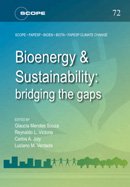
More than 100 experts from around the world contributed to the report, which presents main findings and recommendations on current production and use of bioenergy, as well as growth potential, considering such aspects as land use, feedstocks, technologies, impacts and policies.
Over the past two years 137 experts from 24 countries and 82 institutions have collaborated to analyze a range of issues related to the sustainability of bioenergy production and use. The resulting report Bioenergy & Sustainability: Bridging the Gaps, was launched on Tuesday, April 14th 2015, at FAPESP headquarters. This will be the first in a series of events to discuss its conclusions and recommendations.
The work was coordinated by scientists linked to FAPESP’s Research Programs on Bioenergy (BIOEN), Global Climate Change (RPGCC), and Biodiversity (BIOTA), and was supported by FAPESP and the Scientific Committee on Problems of the Environment (SCOPE), an international nongovernmental organization.
The launch event at FAPESP was be attended by researchers and experts from Brazil and abroad affiliated with universities and research institutions, together with representatives of industry, government and non-governmental organizations. Speakers discussed the current status of bioenergy production, as well as future trends and their effects on policy, communication and innovation strategies.
The report, that references over 2,000 studies, provides a wide-ranging analysis of the current bioenergy landscape, technology, production financing systems and markets, and the potential for sustainable growth of bioenergy use, in parallel with a critical review of its impacts.
The authors consider how bioenergy expansion impacts existing energy systems, food production, environmental and climate security, and sustainable development in both developed and developing regions. They then present their science-based recommendations for policy formulation and for the deployment of a range of bioenergy use options such as liquid biofuels, bioelectricity, biogas and bio-based chemicals, amongst others, in different regions of the world.
The report is divided into five sections. The introduction is followed by an executive summary with technical data and bioenergy numbers offering a comprehensive survey of current biomass production and land use, conversion technologies, future demands and social and environmental benefits.
The third section presents the 4 cross-cutting themes discussed at the December 2013 workshop held at UNESCO in Paris, France, organised by SCOPE: energy security, food security, environmental and climate security, sustainable development and innovation, and filling in the knowledge gaps for sustainable expansion of bioenergy.
The fourth section consists of commissioned background chapters, the state of the art discussed by experts from a spectrum of disciplines to form the basis for the conclusions and recommendations and cross-cutting themes presented in the previous section. Topics cover land use, sources of biomass for bioenergy, integration with agriculture and forestry, water and soil, greenhouse gas emissions, and the impact of biofuels on biodiversity and ecosystem services, as well as social and economic issues. Section V lists countries and regions cited in the report and keywords of the document.
Highlights
The Bioenergy & Sustainability report calls attention to the value of bioenergy as an alternative power source and an option to reduce the impact of fossil fuel combustion. It also highlights the opportunities for enhancement of energy security and mitigation of climate change through advanced biomass conversion technologies that would also help to offset the negative environmental impact of deforestation and land degradation due to agriculture and cattle grazing.
Another conclusion reached by the authors is that bioenergy production systems based on sustainable practices can help to offset greenhouse gas emissions resulting from land use changes or loss of biodiversity. These technologies and procedures include combinations of different feedstocks, use of co-products, integration of bioenergy with agriculture, pasture intensification, agro-ecological zoning, landscape-level planning, improving yields, and other land management practices adapted to local conditions.
The authors also affirm that sufficient land is available worldwide for expansion of biomass cultivation, that most of this land is in Latin America and Africa, and that the use of these areas for bioenergy production would not represent a threat to food security and biodiversity under certain conditions. Moreover, they present evidence that soil improvement technologies, production chain integration and use of bioenergy byproducts in poor rural areas could boost economic performance, enhance food quality, reduce pollution and create jobs.
To download the complete report (open access) see:
bioenfapesp.org/scopebioenergy/index.php/chapters
Enquiries about the report should be addressed to the Editor Glaucia Souza at
